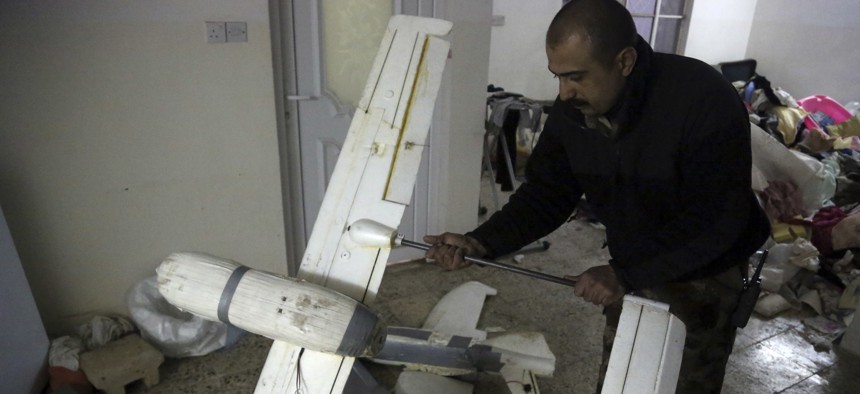
In this Friday, Jan. 27, 2017 photo, an Iraqi officer inspects drones belonging to Islamic State militants in Mosul, Iraq. AP / KHALID MOHAMMED
Counter-Terror Chief: Expect Terrorist Drone Swarms 'Soon'
An upcoming competition will spotlight systems for downing enemy UAVs attacking solo or in groups.
Militaries could face a new threat: swarms of cheap enemy drones, according to one of the nation's counter-terrorism officials.
“It is conceivable that some day soon we will see someone's otherwise capable military security force penetrated, defeated or even overrun by such technologies,” Lt. Gen. Michael Nagata, director of Strategic and Operational Planning at the National Counterterrorism Center, said at the recent Special Operations Forces / Low Intensity Conflict summit.
Nagata has had his share of run-ins with terrorists and extremists. He led President Obama’s ill-fated program to train and equip moderate Syrian rebels.
“What could you do with a swarm of weaponized unmanned aerial systems?” asked Nagata. “We need to remember that aerial vehicles are not the only rapidly growing capability when it comes to robotics. Ask yourself what could a robot the size of a penny that can cut through computer cables do to a command control room?”
ISIS has deployed a variety of weaponized consumer drones in recent months, from off-the-shelf DJI Phantoms modified to carry grenades to larger surveillance drones reminiscent of the Russian Eleron-3SV.
In October, a booby-trapped ISIS drone killed the Peshmerga fighters who shot it down.
Such drones are having profound psychological effects on the people of Mosul.
“I'd just gone to the market for some shopping,” one wounded Mosul resident told BBC reporter Wyre Davies. “The next thing I was lying on the ground and looking up. People started pointing up to the sky from where the bomb had come … Where's the security when these machines are hovering over people and killing us?"
Nagata noted the growing use of commercial drones by U.S. adversaries.
“I believe that is only a harbinger of what is coming as this technology grows in both capability, availability and costs continue to drop,” he said. “The question is no longer will somebody be able to do such things some day? Or how do we stop this from happening in the future? I would argue this is something we need to be asking ourselves right now.”
Hard-Kill Challenge
The Pentagon has been accelerating its efforts to get drone-defeating technology to the front lines.
On Monday, the Joint Improvised Threat Defeat Organization, or JIDO, commenced its latest “Hard Kill’ challenge, which is a bit like American Idol for drone killing. Ten teams of Defense Department contractors and foreign entities will demonstrate their gear to officials from JIDO U.S. Central Command; the Program Directorate Counter-Rocket Artillery Mortar Missiles, or PD C-RAM; and other U.S. agencies and coalition partners, a JIDO representative said.
The challenge’s three phases are based on killing drones up to 250 meters away. As the competition advances through the rounds, the drones will come faster and at greater volume from multiple directions.
“Our commanders are very interested in being able to counter, for themselves and partner forces, these commercial UASs that are showing up on the battlefield,” James Smith, the deputy director of acquisition for U.S. Special Operations Command, told a group at the Global SOF Symposium in Tampa last week. “We are working those very rapidly...A lot of those systems tend to be fixed-site” — not fully mobile — “a setup-and-teardown type of thing. We are looking, for our operations, very agile operations, can we get those systems more agile. More mobile.”
But for all the increased attention, consumer drone tech continues to outpace the ability of allied militaries to procure counter-UAV equipment. Consider the roughly 18-gram Black Hornet mini-drone series from Norwegian-based Prox Dynamics, the smallest tactical drone ever deployed for image capture. Arne Skjaerpe, Prox Dynamics USAs’ general manager, could not predict how much smaller they would become, but did believe they would be much more capable by 2020. “The only thing I know is that in three years, there will be a new one.”
Correction: An earlier version of this article misstated Lt. Gen. Michael Nagata's job title.




